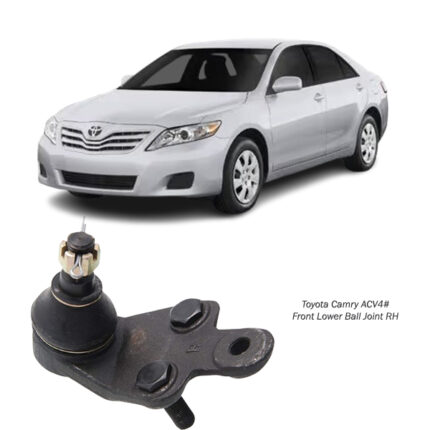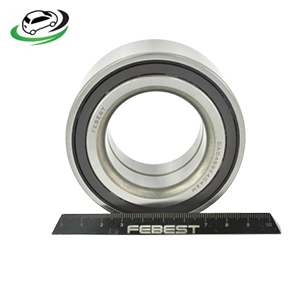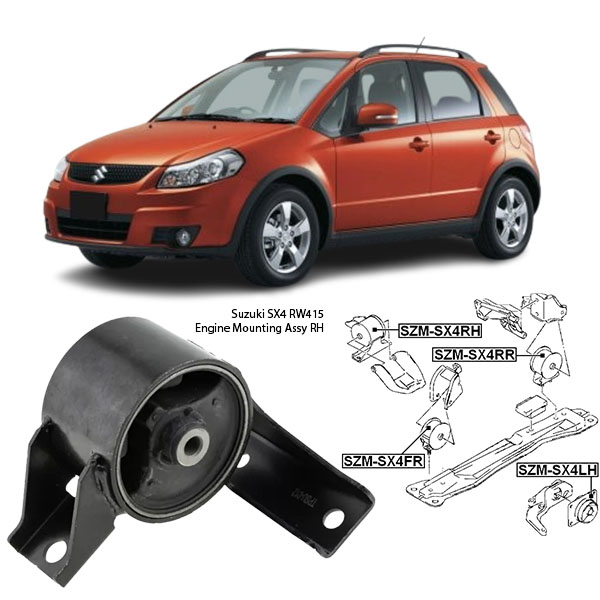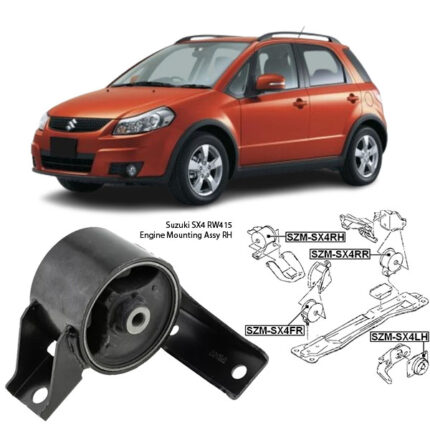-14%
Get Suzuki SX4 RW415 Engine Mounting Assy RH SZM-SX4RH in Kenya
An engine mounting assembly, commonly referred to as an engine mount, is a critical component of a vehicle’s engine and transmission system. Its primary purpose is to secure the engine and, in some cases, the transmission to the vehicle’s chassis. Engine mounts play a crucial role in maintaining the stability, alignment, and performance of the engine. Here’s a detailed definition and an in-depth look at its functions and components:
Components of an Engine Mounting Assembly:
- Mounting Brackets: These are typically made from high-strength steel or aluminum and are bolted to the engine block and the vehicle frame. They provide the structural connection points.
- Rubber or Elastomer Bushings: These components absorb and dampen vibrations and shocks from the engine, preventing them from being transferred to the vehicle’s cabin. The rubber or elastomer bushings also allow for some flexibility and movement, accommodating engine motion.
- Hydraulic or Fluid-Filled Chambers: Some modern engine mounts incorporate hydraulic or fluid-filled chambers to further enhance vibration damping and isolation.
- Insulating Materials: These materials, often rubber or synthetic elastomers, help to isolate the engine vibrations and reduce noise.
- Metal Housing: The outer casing that encapsulates the rubber or hydraulic elements, providing protection and structural integrity.
Benefits;
1. Vibration and Noise Reduction:
- Isolation of Vibrations: Engine mounts are designed to absorb and dampen engine vibrations, preventing them from being transmitted to the vehicle’s chassis and cabin. This ensures a smoother and quieter ride.
- Noise Reduction: By isolating the engine from the chassis, engine mounts significantly reduce the noise that would otherwise enter the passenger compartment, enhancing the overall driving experience.
2. Engine Stability and Alignment:
- Maintains Engine Position: Engine mounts securely hold the engine in place, maintaining its proper alignment within the engine bay. This stability is essential for the correct functioning of various engine components and systems.
- Prevents Excessive Movement: During acceleration, deceleration, and cornering, engine mounts prevent excessive engine movement, protecting engine components from damage due to misalignment or excessive shifting.
3. Improved Handling and Safety:
- Enhanced Vehicle Handling: By securing the engine in a stable position, engine mounts contribute to better vehicle handling and stability. This is particularly important during high-speed driving and sudden maneuvers.
- Safety in Collisions: Engine mounts can help maintain engine position in minor collisions, preventing the engine from shifting and potentially causing more damage or danger to the occupants.
4. Protection of Adjacent Components:
- Reduces Wear and Tear: By minimizing engine movement, engine mounts reduce the wear and tear on adjacent components such as the exhaust system, drive shafts, and hoses. This prolongs the lifespan of these components and reduces maintenance costs.
- Prevents Damage: Excessive engine movement can cause components to collide, leading to damage. Engine mounts help prevent such collisions by keeping the engine securely in place.
5. Enhanced Driving Comfort:
- Smoother Ride: Engine mounts contribute to a smoother and more comfortable ride by absorbing engine vibrations and shocks, which would otherwise be felt by the passengers.
- Reduced Driver Fatigue: By minimizing noise and vibrations, engine mounts help reduce driver fatigue, making long drives more comfortable and less tiring.
6. Longevity of the Engine and Vehicle:
- Prolongs Engine Life: By preventing excessive vibrations and maintaining proper alignment, engine mounts help reduce stress on the engine components, contributing to longer engine life.
- Protects Chassis Integrity: By isolating vibrations and preventing undue stress on the chassis, engine mounts help maintain the structural integrity of the vehicle over time.
7. Compatibility with Modern Technologies:
- Support for Advanced Systems: Modern engine mounts are often designed to work in conjunction with advanced vehicle systems such as active noise control and adaptive suspension systems, enhancing overall vehicle performance.
- Hydraulic and Electronic Mounts: Some modern vehicles use hydraulic or electronically controlled engine mounts that can adjust their damping properties to suit different driving conditions, providing optimal balance between comfort and performance.
Signs a car Needs a new one;
1. Excessive Engine Movement:
- Visible Engine Movement: Excessive movement of the engine, particularly during acceleration, deceleration, or shifting gears, suggests that the engine mounts are not providing adequate support.
- Engine Rocking or Shifting: Noticeable rocking or shifting of the engine when starting or stopping the engine is a clear indicator of worn mounts.
2. Increased Vibrations and Noise:
- Cabin Vibrations: A significant increase in vibrations felt inside the cabin, especially at idle or during acceleration, often points to failing engine mounts. These vibrations can become more pronounced as the mounts deteriorate.
- Unusual Noises: Clunking, banging, or knocking noises coming from the engine bay, particularly during acceleration or deceleration, are symptomatic of loose or damaged engine mounts. These noises occur because the engine is moving excessively and making contact with other components.
3. Poor Engine Alignment:
- Misalignment of Engine Components: Worn engine mounts can lead to the misalignment of various engine components, such as the exhaust system or driveshafts, causing abnormal contact, wear, or noise.
- Strained Hoses and Cables: Misaligned engine components can place undue stress on hoses and cables, potentially causing them to stretch, crack, or disconnect.
4. Steering and Handling Issues:
- Steering Problems: Worn engine mounts can affect steering responsiveness and stability. The vehicle may feel less controlled or experience difficulty maintaining a straight line.
- Reduced Handling: Compromised engine mounts can lead to handling issues, especially during cornering or sudden maneuvers, as the engine’s shifting weight affects the vehicle’s balance.
5. Visual Inspection:
- Visible Damage or Wear: A thorough visual inspection of the engine mounts can reveal cracks, tears, or other damage in the rubber or metal components. Any signs of wear or deterioration indicate that the mounts need to be replaced.
- Leaking Fluid: Some engine mounts are hydraulic or fluid-filled to enhance vibration damping. Fluid leakage from these mounts is a clear sign of failure.
6. Abnormal Engine Behavior:
- Engine Sag: If the engine appears to be sagging or sitting lower in the engine bay than usual, it can indicate that the mounts are not holding the engine securely.
- Delayed Engine Response: A delay in engine response when accelerating or shifting gears can result from excessive engine movement due to worn mounts.
Follow us on Facebook for more parts.




